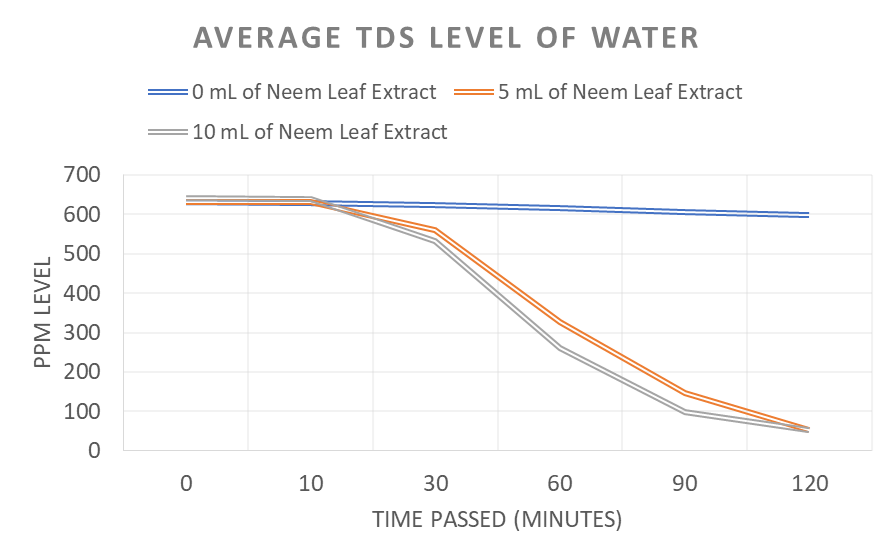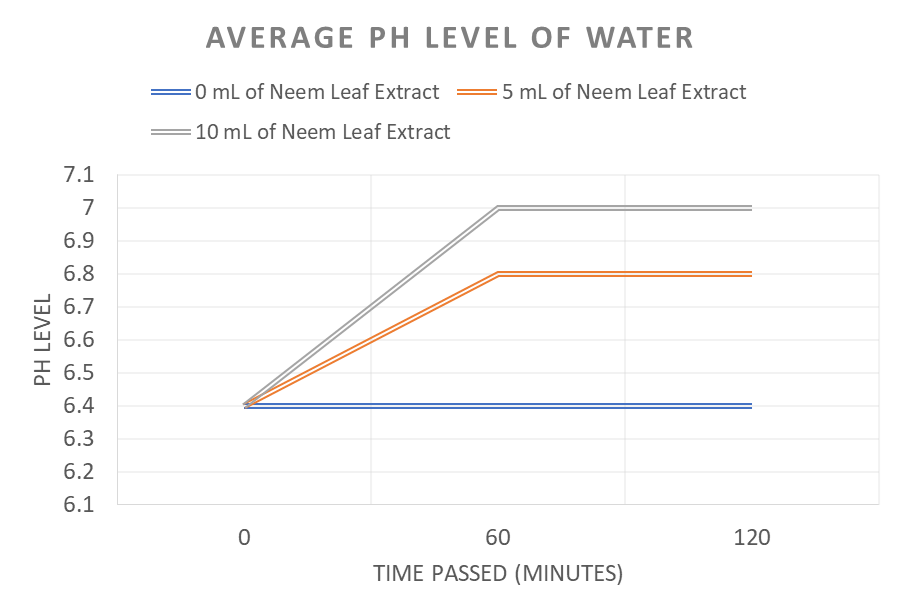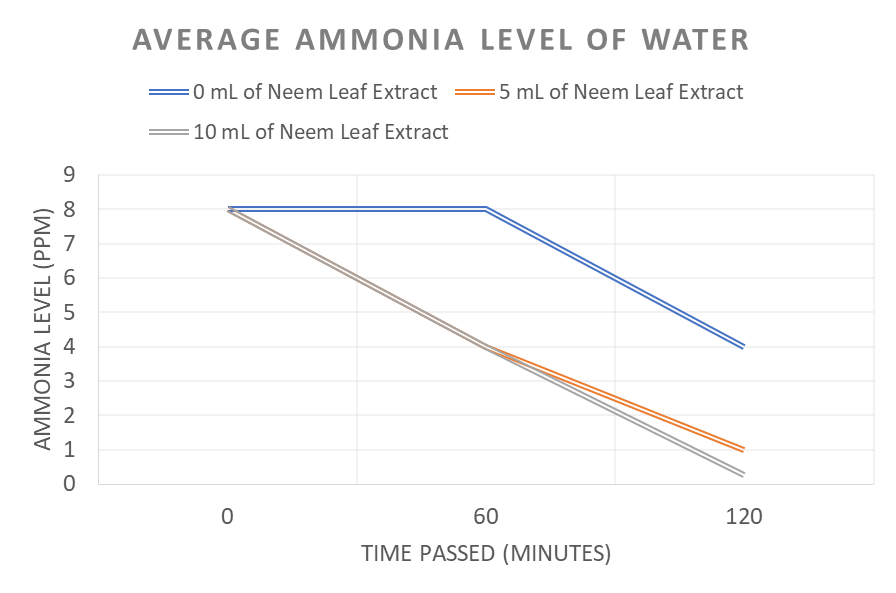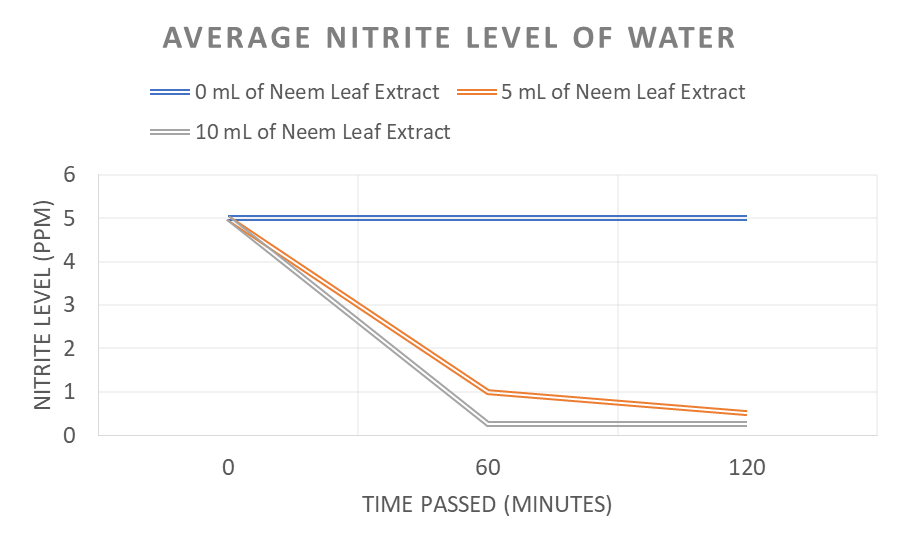Abstract
This investigation aimed to determine if Azadirachta indica (neem) could purify lake water contaminated with sediment, microorganisms, and bacteria. Different concentrations of neem leaf extract were tested on 250 mL of the polluted lake water. The pH, TDS, ammonia, nitrite, and nitrate levels were measured, and data supported that neem can purify contaminated water. The bioactivity of the neem leaf allows it to act as a disinfectant with antibacterial properties.
Introduction
According to the World Health Organization, about 2 billion people worldwide utilize feces-contaminated water sources. As a result, many people are infected by water-related diseases and suffer extreme health consequences or even death. The objective of this research was to use Azadirachta indica (neem), a plant noted for its antibacterial and antimicrobial properties, to treat contaminated lake water, representing the water that some countries utilize as drinking sources. One way to determine if water is safe to drink is by measuring the pH, TDS, ammonia, nitrite, and nitrate levels.
Experimental Details
For this project, dried neem leaves were ground using a mortar and pestle and steeped in water to create an extract. Nine beakers with 250mL of lake water were assembled. The first three beakers, as the control, were treated with 0mL of the neem leaf extract. The second three beakers were treated with 5mL of the extract. The third three beakers were treated with 10mL of the extract. All mixtures were then stirred and left for two hours. In the end, the mixtures were passed through a paper filter to remove the sunken particles and contaminants. Data was measured throughout the experiment at different times using a TDS meter, pH test solution, ammonia test solution, nitrite test solution, and nitrate test solution. The levels were then averaged out in the respective group and the time interval they were measured at.
Results & Discussion
The TDS, ammonia, nitrite, and nitrate levels of the water all decreased the most when treated with the highest concentration of the neem leaf extract. The pH of the water increased the most, going from slightly acidic to basic when treated with the highest concentration of neem leaf extract. The increase in pH and decreases in PPM indicates cleaner water. In addition, the water went from being brown, murky, and cloudy in color to clear. These results demonstrate that neem can purify water contaminated with microorganisms, bacteria, and other toxins. This is most likely due to the chemical composition of the leaf, relating to its unique limonoids and phytochemicals.
Conclusion
The purpose of this experiment was to determine if neem is sufficient enough to purify water. According to the results, the neem leaf extract was able to decontaminate the water, and therefore, the hypothesis is supported. There was a trend of the control, solutions not treated with the extract, to experience minor changes, whereas the solutions treated with the neem leaf extract had significant changes. The solutions with the highest concentration of extract experienced the most drastic change. The pH became more neutral, and the TDS PPM, ammonia PPM, nitrite PPM, and nitrate PPM all decreased to healthier conditions. The bioactivity of the leaf allows for such results. In addition to killing microorganisms and bacteria, causing them to sink with the other toxins, the neem leaf extract simultaneously balanced out the TDS, pH, ammonia, nitrite, and nitrate levels. They are additionally affected by the presence of microorganisms. Therefore, neem leaf extract can purify water, making it safe for human consumption.
Graphs

Figure 1. The average TDS level of the water throughout the experiment.

Figure 2. The average pH level of the water throughout the experiment.

Figure 3. The average ammonia level of the water throughout the experiment.

Figure 4. The average nitrite level of the water throughout the experiment.

Figure 5. The average nitrate level of the water throughout the experiment.
Acknowledgements
I would like to thank Mrs. Erin Cernuda for offering me the opportunity to conduct this research and Mr. Eric Castaing for guiding me through this study. I would also like to thank the Florida State Science and Engineering Fair for allowing me to present my work to other scientists.
References
World Health Organization. (2022, March 21). Drinking-water. World Health Organization., https://www.who.int/news-room/fact-sheets/detail/drinking-water
Hallal, F. (2021, May 28). What is neem extract? benefits, uses, risks, and side effects. Healthline, https://www.healthline.com/nutrition/neem#what-it-is
Aarthy, T., Mulani, F. A., Pandreka, A., Kumar, A., Nandikol, S. S., Haldar, S., & Thulasiram, H. V. (2018, October 11). Tracing the biosynthetic origin of limonoids and their functional groups through stable isotope labeling and inhibition in neem tree (Azadirachta indica) cell suspension - BMC Plant Biology. BioMed Central., https://bmcplantbiol.biomedcentral.com/articles/10.1186/s12870-018-1447-6
Alzohairy M. A. (2016). Therapeutics Role of Azadirachta indica (Neem) and Their Active Constituents in Diseases Prevention and Treatment. Evidence-based complementary and alternative medicine : eCAM, 2016, 7382506. https://doi.org/10.1155/2016/7382506








